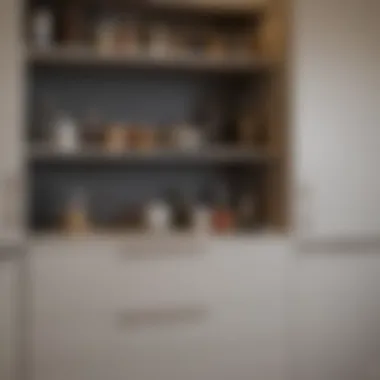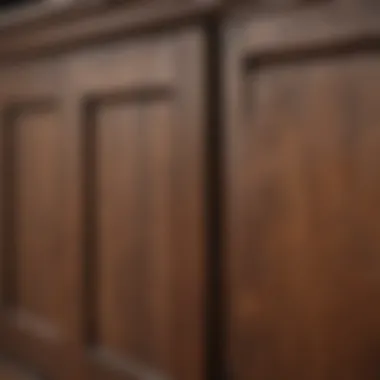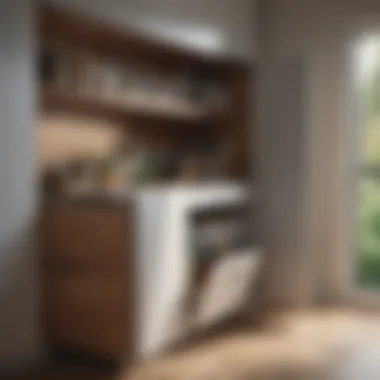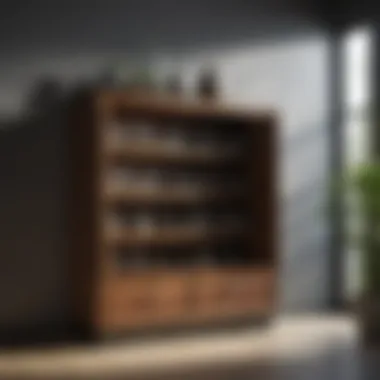Refurbishing Cupboards: A Comprehensive Guide


Intro
Refurbishing cupboards can be a gratifying endeavor. Not only does it breathe new life into tired spaces, but it also enhances storage solutions tailored to your unique style. Whether you have outdated kitchen cabinets or old wardrobes, a thoughtful refurbishing can transform them entirely. This guide will navigate through this process, focusing on methods, materials, and design principles aimed explicitly at homeowners and design enthusiasts.
Design Inspiration
Trending Styles
When refurbishing cupboards, the first step is often to gather inspiration. Different styles may resonate with various individuals. Popular trends include:
- Minimalism: Clean lines and uncluttered aesthetics are hallmarks of minimalistic design. This style often utilizes neutral colors and natural materials.
- Vintage: A vintage approach often incorporates reclaimed wood and antique finishes. This style evokes a sense of nostalgia, bringing character into your space.
- Modern Farmhouse: This trend blends rustic charm with modern touches. Think of shiplap finishes and classic hardware combined with contemporary colors.
Identifying a preferred style helps establish a basis for your design choices.
Color Palettes
The choice of color can dramatically affect the perception of space. When selecting colors, consider the following:
- Neutral Tones: Whites, grays, and beiges provide a versatile foundation. They often enhance the brightness of the room and make it feel larger.
- Bold Accents: Incorporating bold colors, such as navy or forest green, can make cupboards stand out as focal points.
- Earthy Shades: Warm browns, terracottas, and muted greens can create a calming atmosphere, aligning well with natural themes.
Using complementary or contrasting colors can be effective in achieving desired visual impact.
Practical Tips
Maintenance & Care
Once your cupboards are refurbished, understanding maintenance is essential. Regular cleaning with appropriate products keeps surfaces looking new. Use mild detergents instead of harsh chemicals to prevent damage. For wood finishes, consider wax or specific wood conditioners to maintain the integrity of the finish.
Budgeting & Planning
A key part of refurbishment is careful budgeting and planning. Prior to starting:
- Assess the condition of your cupboards. This helps to determine what changes are necessary.
- Create a detailed cost estimate including materials, tools, and labor if applicable.
- Prioritize tasks based on your budget to ensure successful completion.
Refurbishing cupboards can be approachable with the right knowledge and planning. As you navigate this process, the focus on practical tips and design inspiration can greatly assist in producing remarkable results.
Understanding the Need for Refurbishment
Refurbishing cupboards is more than just an aesthetic choice; it is a crucial aspect to maintaining a home’s appeal and functionality. Over time, cupboards often show signs of wear and tear. Recognizing when it is time to refurbish can prevent further deterioration, preserving both value and usability. This section will detail the importance of refurbishment, focusing on practical insights and advantages that come along with it.
Identifying Signs of Wear
It is easy to ignore the small imperfections that develop over time in cupboards. Some common indicators that refurbishment is needed include:
- Scratches and Scuffs: Frequent use can lead to visible surface damage, impacting the overall look.
- Paint or Finish Peeling: A shabby exterior not only looks unsightly but can also expose the material to moisture.
- Sticky or Stiff Doors: Hardware that becomes unresponsive signifies more than just wear; it can hint at misalignment or structural issues.
- Water Damage: This can result from leaks or humidity, leading to serious structural problems if left unaddressed.
By paying close attention to these signs, homeowners can make informed decisions about when refurbishment is necessary, ultimately extending the life of their cupboards.
Benefits of Refurbishing
Refurbishment offers a myriad of benefits that go beyond improving appearance. Here are the critical advantages:
- Cost-Effectiveness: Refurbishing is often significantly cheaper than replacing entire cupboards. This savings is especially appealing in tight budgets.
- Enhanced Aesthetics: A new finish or color can rejuvenate any space, aligning with contemporary design trends and personal style.
- Increased Home Value: Upgraded cupboards can elevate the perceived value of a home, making it more attractive to potential buyers.
- Sustainability: By choosing to refurbish instead of replace, homeowners contribute to waste reduction, supporting environmental sustainability.
"Refurbishing cupboards not only changes the outlook of your kitchen or storage space but also reflects your personal style while being financially savvy."
Evaluating Your Cupboards
To successfully refurbish cupboards, the first step is often evaluating their current condition. This evaluation is crucial as it helps you determine necessary repairs and informs your design choices. Understanding the materials and construction styles of your cupboards can greatly influence the refurbishment process. It gives insight into whether your cupboards are worth the time and effort to refurbish or if replacement is a more viable option. Additionally, identifying any structural issues can prevent future problems.
Materials and Construction Styles


Cupboards are constructed from a variety of materials, each with its unique characteristics. Common materials include wood, laminate, and metal.
- Wood: Often seen as a popular choice, wooden cupboards can be easily sanded and painted. They offer a classic look and can enhance the aesthetic of any room. However, the type of wood—such as oak, maple, or pine—can influence durability and appearance.
- Laminate: This material is generally more affordable and easy to clean. Its surface can mimic the appearance of wood or other materials. While laminate can be tougher to repair if damaged, it often requires minimal upkeep and is resistant to stains.
- Metal: Metal cupboards provide a modern look and are highly durable. They may require more specialized tools for refurbishment, making them less accessible for DIY projects.
When evaluating your cupboards, consider factors like age and style. Certain designs may be trending, and aligning your refurbishment with contemporary aesthetics can add value.
Assessing Structural Integrity
Evaluating structural integrity is a critical part of the refurbishment process. This step ensures that any underlying problems are addressed before cosmetic upgrades are made. Key aspects of structural integrity include:
- Doors and Hinges: Check if the doors swing open and close smoothly. Misaligned or squeaky doors may indicate issues with hinges that need adjustment or replacement.
- Shelves and Supports: Assess whether shelves are sagging or if supports are damaged. Reinforcing shelves can improve the overall usability of your cupboards.
- Frame Stability: Examine the frame for any loose joints or signs of warping. Tightening screws or applying wood glue can stabilize the structure.
In summary, evaluating cupboards involves analyzing both their materials and structural integrity. By doing this thoroughly, you set a solid foundation for the successful refurbishment, ultimately enhancing both functionality and appearance.
Planning the Refurbishment Process
Planning is critical for any refurbishment project. It lays the foundation for a successful outcome and helps manage both expectations and resources. By engaging in careful planning, homeowners can address their specific needs, avoid pitfalls, and create a more efficient workflow. The refurbishment process demands attention to detail in order to bring the desired change while maintaining functionality and style. This section outlines the key components of the planning phase.
Setting a Budget
Budgeting is one of the most fundamental aspects of refurbishment. A clearly defined budget ensures that expenditures align with your financial capability. When setting a budget for the refurbishment of cupboards, first determine your upper limit. This enables you to gauge what materials and designs you can afford.
Consider breaking down costs into categories such as materials, labor, and any additional features you might want to incorporate. Establishing a contingency fund is also advisable. This additional allocation can cover unexpected costs, which often arise during home improvement projects. By having financial resources planned for surprises, you avoid the frustration and stress of financial overruns.
Choosing a Design Concept
Selecting a design concept is equally important as budget planning. The design serves as the visual framework for the entire project. Design choices help shape the mood and functionality of the space. When you determine how you want your cupboards to look, you create a guideline that influences paint choices, hardware selections, and additional features.
Modern Aesthetics
Modern aesthetics emphasize minimalism and functionality. This style is marked by clean lines and an open feel. Opting for modern design can make your space feel larger and more organized. Key characteristics include the use of neutral colors and materials such as glass or metal. Modern aesthetics are beneficial as they tend to blend well with various decor styles, making it easier to integrate new cupboards into the existing home design. However, one must be careful as overly minimalist designs can sometimes feel sterile or uninviting.
Classic Elegance
Classic elegance draws on traditional elements, infusing space with sophistication and charm. The hallmark of this style often includes intricate moldings and rich wood finishes. It remains popular due to its timeless appeal, working well in both contemporary and historical settings. Unique features include decorative hardware and high-quality materials that add a touch of luxury. While classic elegance creates a warm and inviting atmosphere, it can require a higher investment in quality materials, which might stretch the budget.
Rustic Charm
Rustic charm focuses on a cozy, warm environment. This style often incorporates reclaimed materials and distressed finishes that evoke a sense of history. The key characteristic is the use of earthy tones and textures that create an inviting, lived-in feel. Rustic charm is beneficial as it adds character to a space and aligns well with sustainable design practices. On the downside, it may not suit all contemporary settings and can sometimes clash with ultra-modern decor.
Gathering the Necessary Tools and Materials
In any refurbishing project, success hinges on the proper gathering of tools and materials. This stage forms the backbone of the refurbishment process, dictating not only efficiency but also the quality of the outcome. Choosing the right tools and materials can make a significant difference in execution, thus enhancing your final results. Additionally, investing some time in this phase can save future headaches, improving both the process and the finished look of your cupboards.
Essential Tools for Refurbishing
A well-equipped workstation greatly simplifies your tasks. The following tools are generally essential for a cupboard refurbishment:
- Screwdriver Set: Various sizes for removing hardware and reassembling components.
- Drill: For precise drilling of holes when needed, especially for new fixtures.
- Sander: To prepare surfaces for painting or staining.
- Paintbrushes and Rollers: Critical for the application of paint or stain.
- Measuring Tape: Ensures accuracy in all dimensions, especially when planning shelves or storage solutions.
- Utility Knife: Useful for cutting materials like trim or paper backing.
These tools contribute to an efficient workflow, allowing tasks to be done accurately and quickly.
Selecting Suitable Materials
Paint and Stains
Choosing the right paint or stain is crucial for the durability and aesthetics of the cupboards. Paint offers a solid surface that can change the color dramatically, while stains enhance the natural look of wood. Continuous exposure to sunlight and humidity can affect how these products perform. By opting for high-quality brands, you ensure longevity and easier maintenance.
There are many types of paint available, like acrylic, oil-based, and chalk paints. Each serve specific purposes. Oil-based paints are durable and withstand moisture, but they require longer drying times. Chalk paint, on the other hand, provides a matte finish and often needs a sealant.
Hardware Options


The choice of hardware is another vital aspect that impacts both function and aesthetics. Items such as knobs and hinges should be carefully selected to match the design and function of your cupboards. Stainless steel or brushed nickel are popular choices due to their longevity and resistance to corrosion.
The unique feature about various hardware styles lies in their ability to elevate the overall look. Decorative handles can modernize a kitchen, while rustic options give an old-world charm. However, always consider proper installation guidelines to ensure functionality, which may require slight adjustments during the refurbishment process.
Protective Finishes
Applying protective finishes is an essential final step, enhancing durability and appearance. Various options like polyurethane, varnish, or wax can seal the paint or stain applied earlier. Choosing the right finish prevents moisture and wear, ensuring that your refurbished cupboards will stand the test of time.
Protective finishes differ in application and final look. For example, a matte finish provides a smooth look but is less protective than a glossy finish, which is more resilient and easier to clean. The choice, therefore, hinges on your personal style and practicality.
"The foundation of a well-refurbished cupboard relies on selecting the right tools and materials, impacting its longevity and beauty."
The Refurbishment Process: Step-by-Step Guide
The refurbishment proces is crucial because it transforms outdated or worn cupboards into functional and appealing storage solutions. This section outlines the systematic steps involved, ensuring that each phase is clear and detailed. By following these steps, homeowners can achieve a high-quality finish, and benefit from effective use of space while enhancing the overall aesthetic of their kitchen or living areas.
Disassembly and Preparation
The first step in refurbishing cupboards is disassembly. This involves carefully removing doors, drawers, and any hardware such as knobs or handles. Use a set of screwdrivers to avoid damaging the fixtures. Keep track of all small parts by placing them in labeled containers to prevent loss.
Preparation is equally important. Ensure the workspace is clear and the proper tools are ready. Protect the surrounding area with drop cloths or newspaper. Create a checklist of tasks for the refurbishment process. This planning reduces confusion and enhances productivity.
Repairing Structural Issues
After disassembly, examine the cupboard for structural issues. Look for cracks, loose joints, or water damage. Depending on the extent of the damage, wood glue can be used for minor repairs, while more significant issues may require clamps to hold the structure together until the adhesive sets. For deeper damage, replacing affected panels might be necessary. Chipboard or plywood are good materials for this. Addressing these issues early helps ensure the longevity of your refurbished cupboards.
Sanding and Surface Preparation
Sanding the surfaces is a key step in achieving a smooth finish. Start with a coarse sandpaper to remove any old paint or finishes, and gradually progress to finer grit for a polished effect. Pay special attention to corners and edges to avoid rough spots.
After sanding, clean the surfaces to remove dust and debris. A damp cloth can be useful for this task. Allow the surfaces to dry completely before moving to the next step. Proper preparation ensures that paint and finishes adhere correctly, creating a more durable result.
Applying Paint and Finishes
Choosing the right paint or finish is essential for appearance and durability. Opt for high-quality products that suit the overall design vision. Apply primer before painting, especially if changing colors or working with raw wood. Primers help seal the surface, providing better adhesion.
For painting, use a brush for corners and a roller for flat surfaces. Apply multiple thin coats rather than one thick coat to prevent drips and uneven textures. Allow sufficient drying time between each layer.
Reassembly and Final Touches
Once the paint and finishes are dry, it's time to reassemble the cupboards. Begin by attaching any hardware removed earlier. Ensure screws are tightened but be careful not to over-tighten, which can lead to cracking.
After assembly, inspect the cupboards for any missed spots or areas needing touch-ups. Cleaning surfaces to remove any fingerprints or dust is also essential. Finally, arrange the items inside the cupboards, considering space optimization and accessibility.
Important Note: This refurbished product can significantly enhance not only your home aesthetics but also the value of your space.
By meticulously following these steps, you will ensure that your refurbishment project yields satisfying and lasting results.
Innovative Ideas for Cupboard Refurbishment
Innovative ideas play a crucial role in refurbishing cupboards. These ideas not only enhance the functionality of your storage solutions but also improve the overall aesthetic of your space. Refurbishment can be seen as an opportunity to rethink how you use your cupboards, allowing for better organization and a fresh style tailored to your preferences. By considering creative solutions, you can transform ordinary cupboards into striking features in your home that enhance not just utility, but also beauty.
Choosing innovative designs can optimize space efficiency and address specific needs. For instance, incorporating customizable storage solutions offers personalized options for various items. Attention to detail in design can turn simple refurbishment tasks into visually appealing projects that reimagine traditional cupboards.
Creative Storage Solutions
Creative storage is essential for maximizing the potential of your cupboards. Rather than solely focusing on appearance, consider how to utilize every inch efficiently. Built-in compartments and adjustable shelving can accommodate an array of items from kitchenware to linens.
Some effective possibilities include:
- Pull-out drawers: These allow for easy access to deeper spaces, making retrieval less cumbersome.
- Hanging organizers: Such as hooks or racks, can provide additional space, especially in compact areas.
- Bins and baskets: They can help keep smaller items gathered and tidy.


By implementing these storage solutions, cupboards can reveal their hidden capacity and transform chaotic areas into organized, functional spaces.
Utilizing Open Shelving
Open shelving is becoming an increasingly popular choice in cupboard refurbishment due to its modern aesthetic and practicality. This approach creates a more spacious feel while allowing for easy visibility and access to items. When applied thoughtfully, it can also showcase decorative pieces or frequently used ware.
However, consider a few factors:
- Style consistency: Ensure that the items displayed complement the overall decor of the room. For example, mixing styles can appear cluttered.
- Dust management: Open shelves require regular cleaning, so choose this design if you can commit to upkeep.
- Weight capacity: Use materials that are strong enough to hold the items placed on the shelves without risk of bending or breaking.
By effectively using open shelving, you can achieve a functional and stylish cupboard design.
Incorporating Lighting Elements
Incorporating lighting in cupboard refurbishment can significantly enhance the usability and ambiance of the space. Proper illumination not only aids in functionality but also highlights the aesthetics of your cupboards.
Consider these options for effectively integrating lighting:
- LED strip lights: They can be installed under shelves for continuous, soft lighting.
- Spotlights: These can be positioned to draw attention to specific areas or items, creating focal points.
- Puck lights: These small fixtures offer targeted lighting for drawers or open shelving.
The arrangement of lighting can transform how the items within cupboards are perceived, making them more inviting and accessible, especially in dimly lit spaces.
Effective lighting paired with innovative design not only simplifies organization but elevates practicality, merging form with function beautifully.
Maintaining Your Newly Refurbished Cupboards
Maintaining your newly refurbished cupboards is essential for preserving their aesthetic appeal and functionality. When you invest time and resources into refurbishing, it is crucial not to let this effort diminish over time. Regular maintenance ensures that your cupboards not only look good but also withstand everyday wear and tear. This section will delve into the specifics of maintaining your cupboards, focusing on routine cleaning practices and periodic inspections. Both aspects are vital to prolonging the life of your cupboards, allowing them to serve your needs effectively.
Routine Cleaning Practices
Keeping your cupboards clean is foundational to their maintenance. Dust, grease, and spills can accumulate over time, detracting from both appearance and structural integrity. A consistent cleaning routine will not only enhance the surface finish but also assist in identifying potential problems early.
Begin with removing all items from the cupboards. This allows for a thorough cleaning and inspection of the interior and exterior. Use a soft cloth or sponge along with a mild detergent for the surfaces. Avoid abrasive cleaners, which can scratch and damage finishes.
- Use a damp cloth: This will help lift dirt without harming the wood or paint.
- Dry thoroughly: Always dry surfaces immediately after cleaning to avoid moisture damage.
- Apply protective finishes: Depending on your cupboards' material, consider applying a protective wax or clear coat to maintain their sheen and protect against future damage.
Keeping your cupboards clean not only maintains their look but also helps prevent deterioration and extends their life.
Periodic Inspections
Regular inspections are crucial to maintaining your refurbished cupboards. Inspecting helps you catch issues before they turn into significant problems. Schedule inspections at least every six months, or sooner if you notice any changes.
During an inspection, look for signs of damage or wear. Check the hinges, handles, and any moving parts to ensure they function correctly. Pay attention to the following:
- Cracks or splits: Examine the wood for signs of cracking or splitting, which can compromise structural integrity.
- Hardware functionality: Ensure all hinges and handles are secure and operate smoothly. Replace any rusted or broken hardware promptly.
- Finish condition: Look for chipping, peeling, or discoloration in the finish. This may require touch-up paint or refinishing.
Taking these steps ensures that your cupboards continue to be an attractive and functional element of your home.
Ending: The Value of Refurbished Cupboards
Refurbishing cupboards is not only about aesthetic appeal but also about functionality and sustainability. It is a practice that marries design with practical benefits, resulting in spaces that are both beautiful and purposeful. A well-executed refurbishment can elevate the overall ambiance of a home, offering an enhanced user experience. This conclusion serves as an important summation for readers considering the impact of refurbished cupboards.
Sustainable Design Practices
Sustainability plays a key role in modern design. Refurbishing old cupboards can significantly reduce waste associated with manufacturing new furniture. By choosing to restore rather than replace, homeowners actively contribute to environmental conservation.
- Use Eco-Friendly Materials: Opt for paints, stains, and finishes that have low volatile organic compounds (VOCs).
- Upcycling Options: Consider repurposing existing materials. This can include using reclaimed wood or hardware from other projects.
- Energy Efficient Practices: Utilize energy-efficient tools and methods throughout the refurbishment process.
This approach not only extends the life of materials but also aligns with a growing desire for eco-conscious living.
Enhancing Home Aesthetics
The aesthetic benefits of refurbished cupboards can be profound. When a cupboard is refurbished thoughtfully, it acts as a centerpiece. It enhances the kitchen or any space it is placed in, while also showcasing the homeowner’s style.
- Personalized Designs: Tailor finishes and colors to reflect personal tastes. This could be glossy paint for a sleek look or earthy tones for a rustic vibe.
- Functional Décor: Include smart storage solutions that combine beauty and practicality. Box-style inserts or innovative shelving can create an organized and visually pleasing outcome.
- Accents and Hardware: New knobs and handles can transform the appearance without major expense. Simple changes can yield striking results.
An investment in refurbishing cupboards is not merely a cosmetic change but a holistic upgrade that brings life back into a space and enhances its utility.
Ultimately, the value of refurbished cupboards extends beyond their appearance. It encapsulates sustainable practices and a commitment to enhancing home design. Through careful refurbishment, homeowners can achieve a balance of style, function, and environmental responsibility.















